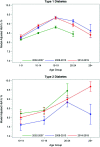Trends in Glycemic Control Among Youth and Young Adults With Diabetes: The SEARCH for Diabetes in Youth Study
- PMID: 34995346
- PMCID: PMC8914430
- DOI: 10.2337/dc21-0507
Trends in Glycemic Control Among Youth and Young Adults With Diabetes: The SEARCH for Diabetes in Youth Study
Abstract
Objective: To describe temporal trends and correlates of glycemic control in youth and young adults (YYA) with youth-onset diabetes.
Research design and methods: The study included 6,369 participants with type 1 or type 2 diabetes from the SEARCH for Diabetes in Youth study. Participant visit data were categorized into time periods of 2002-2007, 2008-2013, and 2014-2019, diabetes durations of 1-4, 5-9, and ≥10 years, and age groups of 1-9, 10-14, 15-19, 20-24, and ≥25 years. Participants contributed one randomly selected data point to each duration and age group per time period. Multivariable regression models were used to test differences in hemoglobin A1c (HbA1c) over time by diabetes type. Models were adjusted for site, age, sex, race/ethnicity, household income, health insurance status, insulin regimen, and diabetes duration, overall and stratified for each diabetes duration and age group.
Results: Adjusted mean HbA1c for the 2014-2019 cohort of YYA with type 1 diabetes was 8.8 ± 0.04%. YYA with type 1 diabetes in the 10-14-, 15-19-, and 20-24-year-old age groups from the 2014-2019 cohort had worse glycemic control than the 2002-2007 cohort. Race/ethnicity, household income, and treatment regimen predicted differences in glycemic control in participants with type 1 diabetes from the 2014-2019 cohort. Adjusted mean HbA1c was 8.6 ± 0.12% for 2014-2019 YYA with type 2 diabetes. Participants aged ≥25 years with type 2 diabetes had worse glycemic control relative to the 2008-2013 cohort. Only treatment regimen was associated with differences in glycemic control in participants with type 2 diabetes.
Conclusions: Despite advances in diabetes technologies, medications, and dissemination of more aggressive glycemic targets, many current YYA are less likely to achieve desired glycemic control relative to earlier cohorts.
© 2022 by the American Diabetes Association.
Figures
References
-
- Nathan DM, Genuth S, Lachin J, et al. .; Diabetes Control and Complications Trial Research Group . The effect of intensive treatment of diabetes on the development and progression of long-term complications in insulin-dependent diabetes mellitus. N Engl J Med 1993;329:977–986 - PubMed
Publication types
MeSH terms
Substances
Associated data
Grants and funding
- UC4 DK108173/DK/NIDDK NIH HHS/United States
- U18 DP006134/DP/NCCDPHP CDC HHS/United States
- U18 DP006138/DP/NCCDPHP CDC HHS/United States
- U18DP006134/ACL/ACL HHS/United States
- U18DP006138/ACL/ACL HHS/United States
- U18 DP002714/DP/NCCDPHP CDC HHS/United States
- U01 DP000248/DP/NCCDPHP CDC HHS/United States
- U18DP006133/ACL/ACL HHS/United States
- U01 DP000244/DP/NCCDPHP CDC HHS/United States
- U18DP006131/ACL/ACL HHS/United States
- K23 HL148394/HL/NHLBI NIH HHS/United States
- L40 HL148910/HL/NHLBI NIH HHS/United States
- U18 DP006139/DP/NCCDPHP CDC HHS/United States
- R01 DK127208/DK/NIDDK NIH HHS/United States
- K23 DK119465/DK/NIDDK NIH HHS/United States
- U18 DP002708/DP/NCCDPHP CDC HHS/United States
- HIR 10-001/HX/HSRD VA/United States
- U01 DP000247/DP/NCCDPHP CDC HHS/United States
- U18DP006136/ACL/ACL HHS/United States
- U18 DP006131/DP/NCCDPHP CDC HHS/United States
- P30 DK092926/DK/NIDDK NIH HHS/United States
- U18 DP002710/DP/NCCDPHP CDC HHS/United States
- U18 DP006136/DP/NCCDPHP CDC HHS/United States
- U18 DP002709/DP/NCCDPHP CDC HHS/United States
- U18 DP006133/DP/NCCDPHP CDC HHS/United States
- EP-C-15-002/EPA/EPA/United States
- U01 DP000250/DP/NCCDPHP CDC HHS/United States
- U18DP006139/ACL/ACL HHS/United States
- U01 DP000246/DP/NCCDPHP CDC HHS/United States
- U01 DP000254/DP/NCCDPHP CDC HHS/United States
LinkOut - more resources
Full Text Sources
Medical


